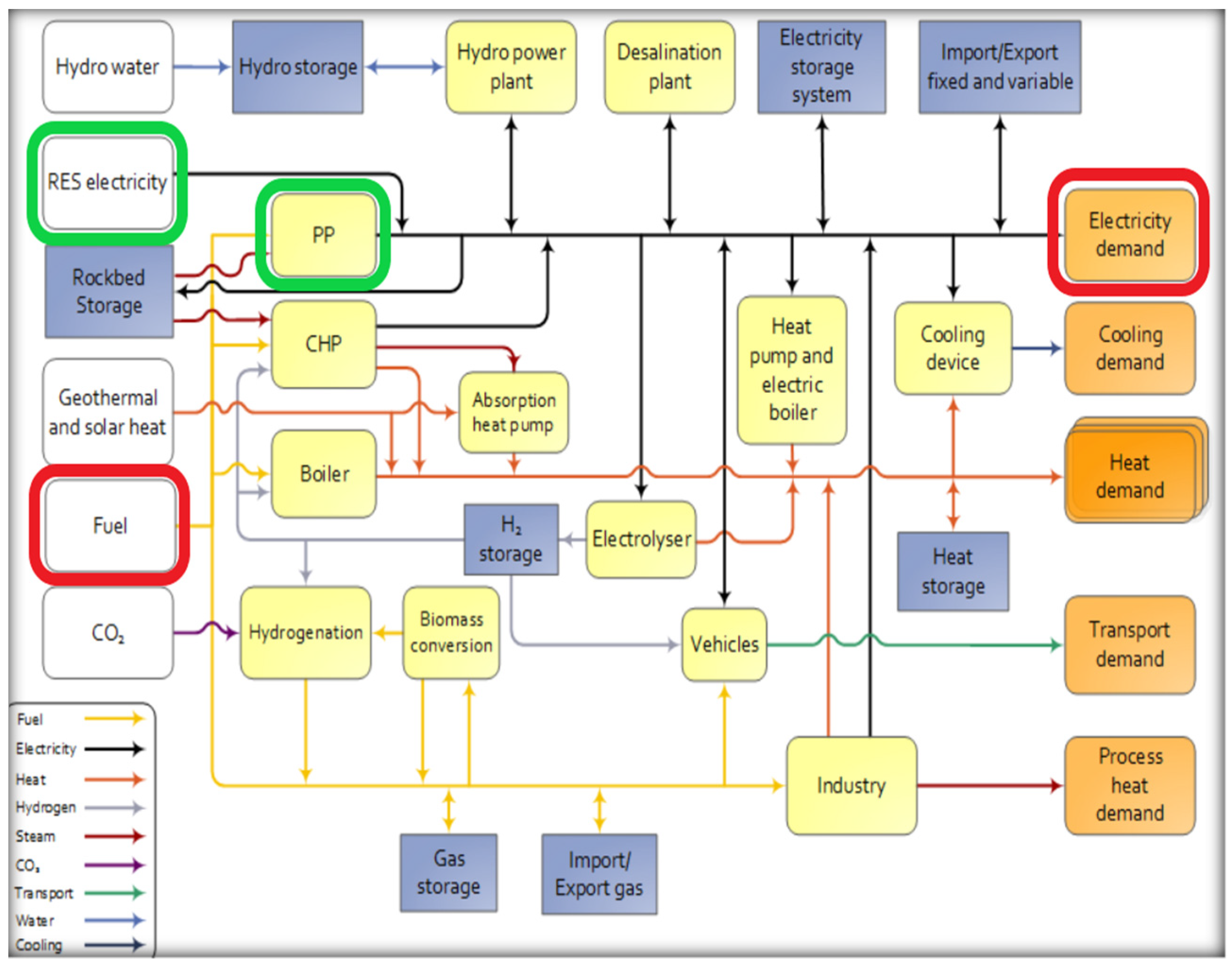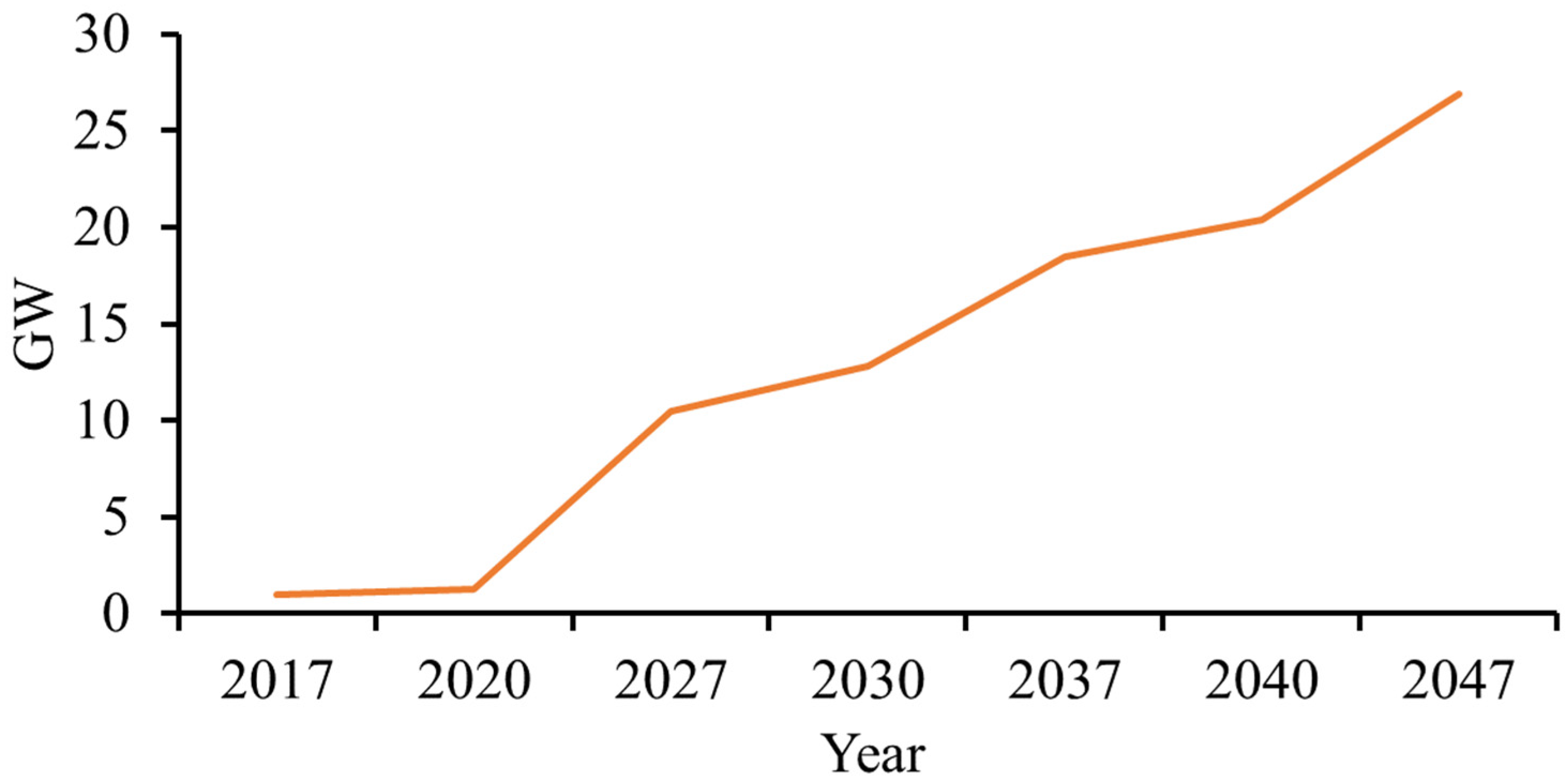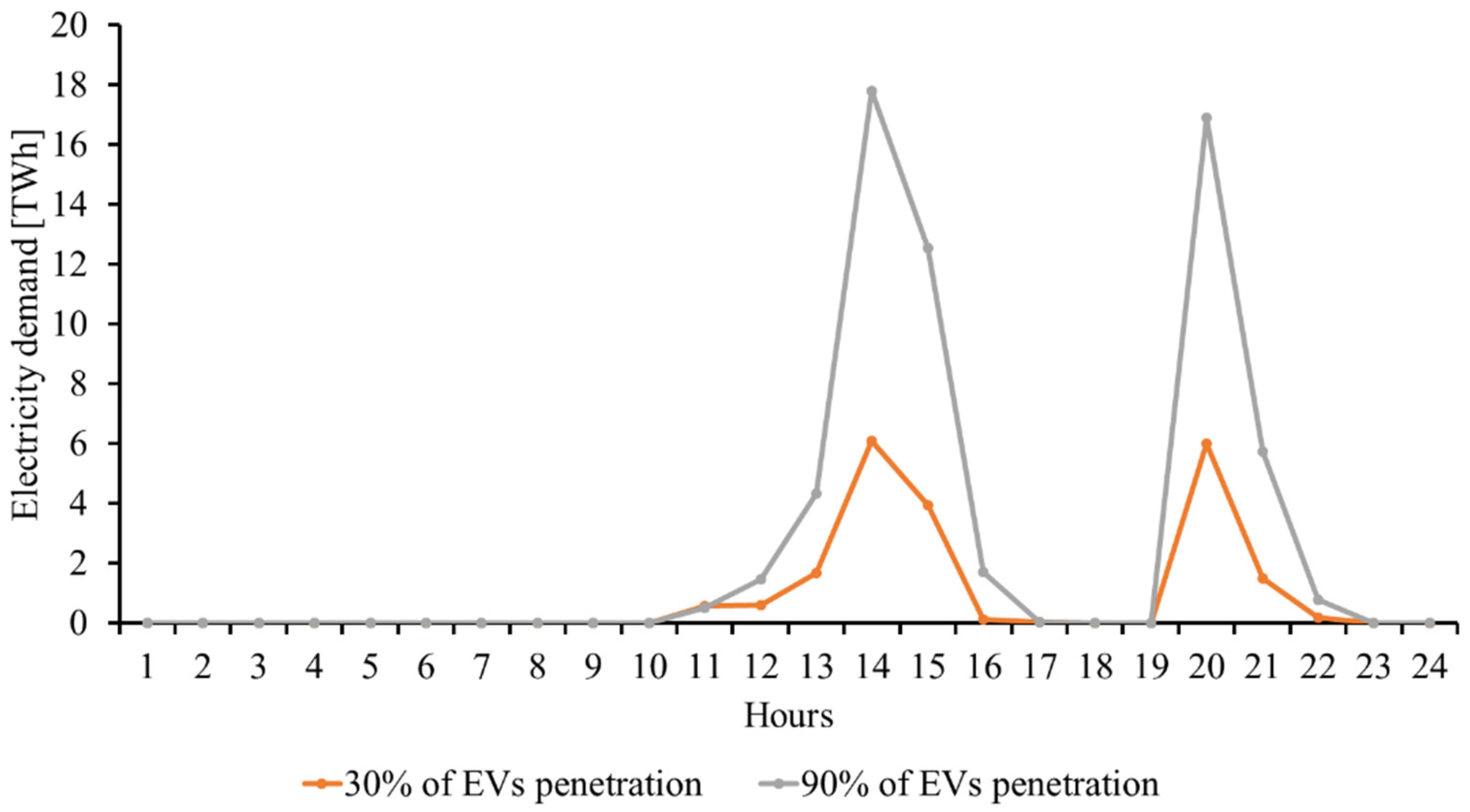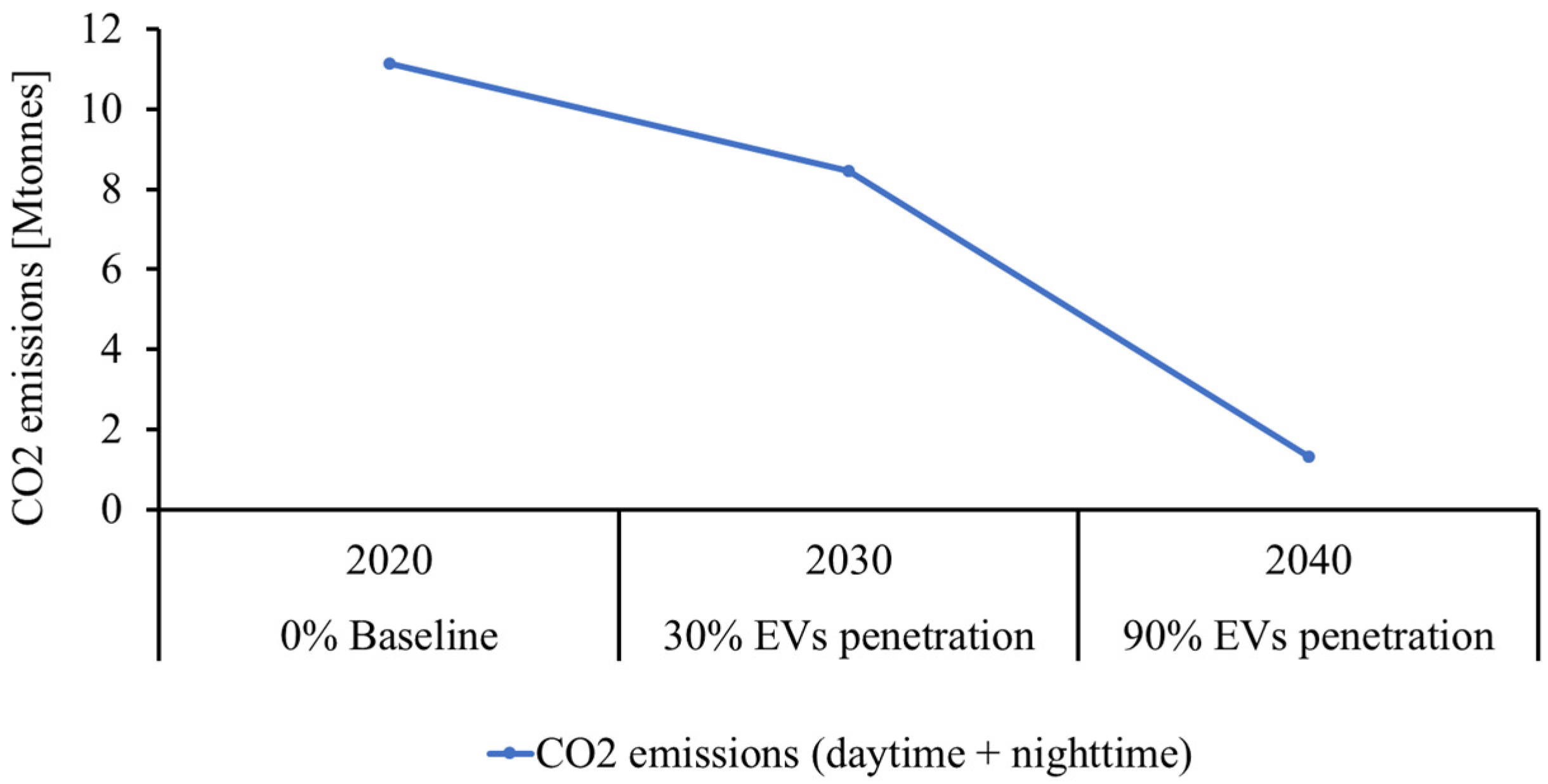Energy-Environmental Planning of Electric Vehicles (EVs): A Case Study of the National Energy System of Pakistan
Abstract
:1. Introduction
2. Comparison of the Proposed Methodology with Others Available in the Literature
3. Energy Modeling
3.1. The ePop Simulator
3.2. The PV Modeling through Renewables.Ninja
3.3. The EnergyPLAN® Software
4. The Case Study of Pakistan
4.1. Current and Possible Future Scenarios
4.1.1. Current Scenario Referred to the Year 2020 (Baseline)
4.1.2. The Future Scenarios (Years 2030 and 2040)
- 30% EVs fleet penetration by adding small and medium vehicles (year 2030);
- 90% EVs fleet penetration (year 2040).
- 12.6 GW of PV capacity in 2030;
- 20.4 GW of PV capacity in 2040.
4.2. The CO2 Emissions of Pakistan
- -
- n is the No. of fossil fuel;
- -
- i is the type of fossil fuel;
- -
- Ei is the yearly consumption of fossil fuel (kWh);
- -
- is the unitary emission for fossil fuel [kgCO2/kWh] [46].
5. Results and Comments
5.1. The EVs’ Electricity Demand
5.2. Reduction of the Fuel Consumption in the Transportation Sector of Pakistan
5.3. Impacts on the Overall CO2 Emissions
6. Conclusions and Recommendations
- The added PV capacity of 2.9 GW during the daytime in the year 2030 will be required to fulfill the EVs’ electricity demand of 4.7 TWh/year. Likewise, for the year 2040 it would be needed 9 GW to meet the EVs’ electricity demand of 14.2 TWh/year;
- In the year 2030, the added power plants’ fossil fuel-based capacity of 0.3 GW will satisfy 2.2 TWh/year during the nighttime for fulfilling the EVs’ electricity demand. Similarly, in the year 2040 it would be required 0.7 GW to meet the EVs’ electricity demand of 4.7 TWh/year;
- The fuel consumption with the penetration of more EVs will reduce from 10 Mtoe (the baseline year 2020) by 1 Mtoe in the year 2030 (30% EVs penetration), and by 3.5 Mtoe in the year 2040 (90% EVs penetration);
- Finally, a reduction in CO2 emissions will be observed, going from 11.13 Mtonnes (the baseline year 2020) to 4 Mtonnes in the year 2030 (30% EVs’ penetration), and 10.4 Mtonnes in the year 2040 (90% EVs’ penetration).
Author Contributions
Funding
Informed Consent Statement
Conflicts of Interest
Nomenclature
| η Charger | Efficiency of the grid to battery connection (charger) |
| ηInverter | Efficiency of the battery to grid connection (inverter) |
Acronyms
| ASEAN | Association of Southeast Asian Nations |
| CNG | Compressed Natural Gas |
| CRI | Climate Risk Index |
| DSF | Depth First Search |
| DPBS | Data Pakistan Bureau of Statistics |
| EPA | Environmental Protection Agency |
| EV | Electric Vehicle |
| FFV | Fossil Fuel Vehicle |
| GHG | Greenhouse Gas |
| ICE | Internal Combustion Engine |
| IEA | International Energy Agency |
| INDC | Intended Nationally Determined Contributions |
| LPG | Low Pressure Gas |
| PV | Photovoltaic |
| NEEDS | National Economic and Environment Development |
| NEPRA | National Electric Power Regulatory Authority |
| NEVP | National Electric Vehicles Policy |
| RES | Renewable Energy Source |
| SOC | State Of Charge |
| toe | tonnes of oil equivalent |
| V2G | Vehicle-to-Grid |
References
- Climate Change|US EPA. Available online: https://www.epa.gov/climate-change (accessed on 14 March 2022).
- Wu, Y.A.; Ng, A.W.; Yu, Z.; Huang, J.; Meng, K.; Dong, Z.Y. A Review of Evolutionary Policy Incentives for Sustainable Development of Electric Vehicles in China: Strategic Implications. Energy Policy 2021, 148, 111983. [Google Scholar] [CrossRef]
- López, I.; Ibarra, E.; Matallana Andreu, J.; Kortabarria, I. Next Generation Electric Drives for HEV/EV Propulsion Systems: Technology, Trends and Challenges. Renew. Sustain. Energy Rev. 2019, 114, 109336. [Google Scholar] [CrossRef]
- Singh, N.; Mishra, T.; Banerjee, R.; Mishra, T.; Banerjee, R.; Mehta, S.J. Greenhouse Gas Emissions in India’s Road Transport Sector, Climate Change Signals and Response; Springer: Singapore, 2018; pp. 197–209. [Google Scholar] [CrossRef]
- Ghosh, A. Possibilities and Challenges for the Inclusion of the Electric Vehicle (EV) to Reduce the Carbon Footprint in the Transport Sector: A Review. Energies 2020, 13, 2602. [Google Scholar] [CrossRef]
- Schey, S.; Scoffield, D.; Smart, J. A First Look at the Impact of Electric Vehicle Charging on the Electric Grid in the EV Project. In Proceedings of the EVS26 International Battery, Hybrid and Fuel Cell Electric Vehicle Symposium, Los Angeles, CA, USA, 6–9 May 2012. [Google Scholar]
- Global EV Outlook 2020—Analysis—IEA. Available online: https://www.iea.org/reports/global-ev-outlook-2020 (accessed on 8 April 2022).
- ESMAP (Energy Sector Management Assistance Program), Bringing Variable Renewable Energy Up to Scale Option for Grid Integration Using Natural Gas and Energy Storage; Technical Report 006/15; The International Bank for Reconstruction and Development: Washington, DC, USA. 2015. Available online: https://openknowledge.worldbank.org/bitstream/handle/10986/21629/ESMAP_Bringing+Variable+Renewable+Energy+Up+to+Scale_VRE_TR006-15.pdf;jsessionid=3C9833F5E118E7D948A44FB049CF9ADE?sequence=4 (accessed on 8 April 2022).
- Bellocchi, S.; Manno, M.; Noussan, M.; Prima, G.M.; Vellini, M. Electrification of Transport and Residential Heating Sectors in Support of Renewable Penetration: Scenarios for the Italian Energy System. Energy 2020, 196, 117062. [Google Scholar] [CrossRef]
- Yuan, M.; Thellufsen, J.Z.; Lund, H.; Liang, Y. The Electrification of Transportation in Energy Transition. Energy 2021, 236, 121564. [Google Scholar] [CrossRef]
- Muneer, T.; Maubleu, S.; Asif, M. Prospects of Solar Water Heating for Textile Industry in Pakistan. Renew. Sustain. Energy Rev. 2006, 10, 1–23. [Google Scholar] [CrossRef]
- Publications|Germanwatch e.V. Available online: https://www.germanwatch.org/en/publications (accessed on 8 April 2022).
- Pakistan’s National Electric Vehicle Policy: Charging towards the Future. Available online: https://theicct.org/pakistans-national-electric-vehicle-policy-charging-towards-the-future/ (accessed on 8 April 2022).
- Muhammad, F.; Waleed Raza, M.; Khan, S.; Khan, F. Different Solar Potential Co-Ordinates of Pakistan. Innov. Energy Res. 2017, 6, 173. [Google Scholar] [CrossRef] [Green Version]
- Kempton, W.; Tomic, J. Vehicle-to-Grid Power Implementation: From Stabilizing the Grid to Supporting Large-Scale Renewable Energy. J. Power Sources 2005, 144, 280–294. [Google Scholar] [CrossRef]
- Chaouachi, A.; Bompard, E.; Fulli, G.; Masera, M.; De Gennaro, M.; Paffumi, E. Assessment Framework for EV and PV Synergies in Emerging Distribution Systems. Renew. Sustain. Energy Rev. 2016, 55, 719–728. [Google Scholar] [CrossRef]
- Ciabattoni, L.; Cardarelli, S.; di Somma, M.; Graditi, G.; Comodi, G. A Novel Open-Source Simulator of Electric Vehicles in a Demand-Side Management Scenario. Energies 2021, 14, 1558. [Google Scholar] [CrossRef]
- Pupo-Roncallo, O.; Ingham, D.; Pourkashanian, M. Techno-economic benefits of grid-scale energy storage in future energy systems. Energy Rep. 2020, 6, 242–248. [Google Scholar] [CrossRef]
- Bartolini, A.; Comodi, G.; Salvi, D.; Østergaard, P.A. Renewables self-consumption potential in districts with high penetration of electric vehicles. Energy 2020, 213, 118653. [Google Scholar] [CrossRef]
- Calise, F.; Liberato Cappiello, F.; Dentice d’Accadia, M.; Vicidomini, M. Smart grid energy district based on the integration of electric vehicles and combined heat and power generation. Energy Convers. Manag. 2021, 234, 113932. [Google Scholar] [CrossRef]
- Wang, M.; Li, T.; Yuan, C.; Tian, H.; Tian, S. Research on vehicle renewable energy use in cities with different carbon emission characteristics. Energy Rep. 2022, 8, 343–352. [Google Scholar] [CrossRef]
- Bastida-Molina, P.; Hurtado-Pérez, E.; Moros Gomez, M.C.; Vargas-Salgado, C. Multicriteria power generation planning and experimental verification of hybrid renewable energy systems for fast electric vehicle charging stations. Renew. Energy 2021, 179, 737–755. [Google Scholar] [CrossRef]
- Harewood, A.; Dettner, F.; Hilpert, S. Open source modelling of scenarios for a 100% renewable energy system in Barbados incorporating shore-to-ship power and electric vehicles. Energy Sustain. Dev. 2022, 68, 120–130. [Google Scholar] [CrossRef]
- Iwai, N.; Kurahashi, N.; Kishita, Y.; Yamaguchi, Y.; Shimoda, Y.; Fukushige, S.; Umeda, Y. Scenario Analysis of Regional Electricity Demand in the Residential and Commercial Sectors—Influence of Diffusion of Photovoltaic Systems and Electric Vehicles into Power Grids. Procedia Cirp 2014, 15, 319–324. [Google Scholar] [CrossRef] [Green Version]
- Brostrom, T.; Babar, B.; Hansen, J.B.; Good, C. The pure PV-EV energy system—A conceptual study of a nationwide energy system based solely on photovoltaics and electric vehicles. Smart Energy 2021, 1, 100001. [Google Scholar] [CrossRef]
- Smith, D.; Graves, R.; Ozpineci, B.; Jones, P.T. Medium- and Heavy-Duty Vehicle Electrification: An Assessment of Technology and Knowledge Gaps; ORNL/SPR-2020/7; Oak Ridge National Laboratory (ORNL): Oak Ridge, TN, USA; National Renewable Energy Laboratory (NREL): Golden, CO, USA, 2019. Available online: https://info.ornl.gov/sites/publications/Files/Pub136575.pdf (accessed on 8 April 2022).
- Petkov, I.; Gabrielli, P. Power-to-hydrogen as seasonal energy storage: An uncertainty analysis for optimal design of low-carbon multi-energy systems. Appl. Energy 2020, 274, 115197. [Google Scholar] [CrossRef]
- Trentadue, G.; Lucas, A.; Otura, M.; Pliakostathis, K.; Zanni, M.; Scholz, H. Evaluation of Fast Charging Efficiency under Extreme Temperatures. Energies 2018, 11, 1937. [Google Scholar] [CrossRef] [Green Version]
- NationMastr: Pakistan Transport Stats. Available online: https://www.nationmaster.com/country-info/profiles/Pakistan/Transport (accessed on 8 April 2022).
- Jolta Electric EBike JE-70D. Available online: https://www.joltaelectric.com/models/JE-70D.html (accessed on 8 April 2022).
- Hero Electric—Best Electric Bikes & Scooters in India. Available online: https://heroelectric.in/ (accessed on 8 April 2022).
- PURE EV Epluto Specifications & Features, Mileage, Weight. Available online: https://www.zigwheels.com/newbikes/PURE-EV/epluto/specifications (accessed on 8 April 2022).
- Mahindra Treo|E Rickshaw—Mahindra Electric. Available online: https://www.mahindraelectric.com/vehicles/treo-electric-auto/ (accessed on 8 April 2022).
- Kinetic Zing Electric Scooter and Bike|Kinetic Green Vehicles. Available online: https://kineticgreenvehicles.com/electric-scooters/zing.html (accessed on 8 April 2022).
- Gayam Motor Works (GMW), an EV Pioneer with Presence in 5 Continents Announces $50Mn Investment Commitment from GEM, as Company Seeks to Go Public in Coming Months|Business Wire. Available online: https://www.businesswire.com/news/home/20210331005905/en/Gayam-Motor-Works-GMW-an-EV-Pioneer-with-Presence-in-5-Continents-Announces-50Mn-Investment-Commitment-from-GEM-as-Company-Seeks-to-Go-Public-in-Coming-Months (accessed on 8 April 2022).
- Renewables.Ninja. Available online: https://www.renewables.ninja/ (accessed on 8 April 2022).
- Staffell, I.; Pfenninger, S. Using Bias-Corrected Reanalysis to Simulate Current and Future Wind Power Output. Energy 2016, 114, 1224–1239. [Google Scholar] [CrossRef] [Green Version]
- Pfenninger, S.; Staffell, I. Long-Term Patterns of European PV Output Using 30 Years of Validated Hourly Reanalysis and Satellite Data. Energy 2016, 114, 1251–1265. [Google Scholar] [CrossRef] [Green Version]
- EnergyPLAN|Advanced Energy Systems Analysis Computer Model. Available online: https://www.energyplan.eu/ (accessed on 8 April 2022).
- Connolly, D.; Lund, H.; Mathiesen, B.; Leahy, M. The First Step towards a 100% Renewable Energy-System for Ireland. Appl. Energy 2011, 88, 502–507. [Google Scholar] [CrossRef]
- Dorotić, H.; Doračić, B.; Dobravec, V.; Puksec, T.; Krajacic, G.; Duic, N. Integration of Transport and Energy Sectors in Island Communities with 100% Intermittent Renewable Energy Sources. Renew. Sustain. Energy Rev. 2019, 99, 109–1241. [Google Scholar] [CrossRef]
- Documentation|EnergyPLAN. Available online: https://www.energyplan.eu/training/documentation/ (accessed on 8 April 2022).
- Pakistan Bureau of Statistics. Available online: https://www.pbs.gov.pk/ (accessed on 8 April 2022).
- Electric Vehicles in Pakistan: Policy Recommendations. Available online: https://lei.lums.edu.pk/index.php/electric-vehicles-in-pakistan-policy-recommendations/ (accessed on 8 April 2022).
- Aslam, H.; Ahmed, V.; Williamson, M.; Rana, F.; Rehman Zia, U. Reform Priorities for Pakistan’s Energy Sector Perspectives in the Backdrop of Paris Agreement This Brief Draws from the Extensive Workshops on the Subject Led by the United Nations Economic and Social Commission for Asia and the Pacific (UNESCAP) and the Sustainable Development Policy Institute (SDPI) under the Project ’Evidence Based Policies for Sustainable Use of Energy Resources. Available online: https://repository.unescap.org/handle/20.500.12870/2901 (accessed on 8 April 2022).
- Specific Carbon Dioxide Emissions of Various Fuels. Available online: https://www.volker-quaschning.de/datserv/CO2-spez/index_e.php (accessed on 8 April 2022).
- Motorcycles Sales Database—80 Countries, All Brands & Models. Available online: https://www.motorcyclesdata.com/ (accessed on 8 April 2022).
- Schröder, M.; Iwasaki, F. Promotion of Electromobility in ASEAN: States, Carmakers, and International Production Networks. ERIA 2021. Research Project Report. Available online: https://www.eria.org/publications/promotion-of-electromobility-in-asean-states-carmakers-and-international-production-networks/ (accessed on 8 April 2022).
- Haslback, J.; Kuehn, N.; Lewis, E.; Pinkerton, L. Bituminous Coal and Natural Gas to Electricity. In Cost and Performance Baseline for Fossil Energy Plants. Available online: https://www.netl.doe.gov/projects/files/CostAndPerformanceBaselineForFossilEnergyPlantsVol1BitumCoalAndNGtoElectBBRRev4-1_092419.pdf (accessed on 8 April 2022).
- Torchio, M.; Santarelli, M. Energy, Environmental and Economic Comparison of Different Powertrain/Fuel Options Using Well-to-Wheels Assessment, Energy and External Costs–European. Energy 2010, 35, 4156–4171. [Google Scholar] [CrossRef]
- Spath, P.L.; Mann, M.K.; Kerr, D.R. Life Cycle Assessment of Coal-Fired Power Production; National Renewable Energy Lab (NREL): Golden, CO, USA, 1999. [Google Scholar] [CrossRef] [Green Version]
- Ren, L.; Zhou, S.; Ou, X. Life-Cycle Energy Consumption and Greenhouse Gas Emissions for Electricity Generation and Supply in China. Energy 2020, 209, 118482. [Google Scholar] [CrossRef]
- Fioreze, M.; Honnicke, M. Montagem de Dispositivos Ópticos para Obtenção de Imagens por Contraste de Difração e Atenuação para Análise de Incrustações de Fosfato e Oxalato de Cálcio em Superfícies de Caldeiras. 2016. Available online: https://dspace.unila.edu.br/bitstream/handle/123456789/637/Montagem%20de%20Dispositivos%20Opticos%20para%20Obtencao%20de%20Imagens%20por%20Contraste%20de%20Difracao%20e%20Atenuacao%20para%20Analise%20de%20Incrustacoes%20de%20Fosfato%20e%20Oxalato%20de%20C%C3%A1lcio%20em%20Superficies%20de%20Caldeiras.pdf?sequence=1&isAllowed=y (accessed on 8 April 2022).
- Suppes, G.J.; Storvick, T.S. Production of Electricity. In Sustainable Nuclear Power; Academic Press: Cambridge, MA, USA, 2007; pp. 185–200. [Google Scholar] [CrossRef]
- Travesset-Baro, O.; Rosas-Casals, M.; Jover, E. Transport Energy Consumption in Mountainous Roads. A Comparative Case Study for Internal Combustion Engines and Electric Vehicles in Andorra. Transp. Res. Part D Transp. Environ. 2015, 34, 16–26. [Google Scholar] [CrossRef] [Green Version]
- Hekkert, M.; Hendriks, F.; Faaij, A.; Neelis, M. Natural Gas as an Alternative to Crude Oil in Automotive Fuel Chains Well-to-Wheel Analysis and Transition Strategy Development. Energy Policy 2005, 33, 579–594. [Google Scholar] [CrossRef] [Green Version]
- Linssen, J.; Schindler, V.; Danzer, M.A.; Schmitz, P.; Marker, S.; Lindwedel, E.; Günther, C.; Strunz, K.; Maas, H.; Waldowski, P.; et al. Netzintegration von Fahrzeugen mit elektrifizierten Antriebssystemen in bestehende und zukünftige Energieversorgungsstrukturen—Advances in Systems Analysis 1; Forschungszentrum Jülich’s Publishing House: Jülich, Germany, 2012. [Google Scholar]
- Albatayneh, A.; Assaf, M.; Alterman, D.; Jaradat, M. Comparison of the Overall Energy Efficiency for Internal Combustion Engine Vehicles and Electric Vehicles. Environ. Clim. Technol. 2020, 24, 669–680. [Google Scholar] [CrossRef]
- Allik, A.; Märss, M.; Uiga, J.; Annuk, A. Optimization of the Inverter Size for Grid-Connected Residential Wind Energy Systems with Peak Shaving. Renew. Energy 2016, 99, 1116–1125. [Google Scholar] [CrossRef]
- Amin Aslam Khan, M.; Amir, P.; Ahmad Ramay Zuhair Munawar, S.; Ahmad, D. National Economic & Environmental Development Study (NEEDS). 2011. Available online: https://unfccc.int/topics/climate-finance/workstreams/determination-of-the-needs-of-developing-country-parties-related-to-implementing-the-convention-and/national-economic-environment-and-development-study-needs-for-climate-change-project (accessed on 8 April 2022).
- Pakistan’s Intended Nationally Determined Contribution (Pak-INDC). Available online: https://www4.unfccc.int/sites/ndcstaging/PublishedDocuments/Pakistan%20First/Pak-INDC.pdf (accessed on 8 April 2022).
- CO2 Emissions from Gaseous Fuel Consumption (Kt)—Pakistan|Data. Available online: https://data.worldbank.org/indicator/EN.ATM.CO2E.GF.KT?end=2018&locations=PK&start=2003&view=chart (accessed on 8 April 2022).
- Yang, L.; Yu, B.; Yang, B.; Chen, H.; Malima, G.; Wei, Y.M. Life cycle environmental assessment of electric and internal combustion engine vehicles in China. J. Clean. Prod. 2021, 285, 124899. [Google Scholar] [CrossRef]
- Yuan, C.; Deng, Y.; Li, T.; Yang, F. Manufacturing energy analysis of lithium ion battery pack for electric vehicles. CIRP Ann. 2017, 66, 53–56. [Google Scholar] [CrossRef]
- Asia|Transport Policy. Available online: https://www.transportpolicy.net/region/asia/ (accessed on 8 April 2022).
- Pakistan’s Installed Capacity May Rise by over 40% to 57 GW in 2030|Enerdata. Available online: https://www.enerdata.net/publications/daily-energy-news/pakistans-installed-capacity-may-rise-over-40-57-gw-2030.html (accessed on 8 April 2022).
- European Environmental Agency, Electric Vehicles from Life Cycle and Circular Economy Perspectives. TERM 2018: Transport and Environment Reporting Mechanism (TERM) Report, EEA Report No 13/2018, ISSN 1977–8449. Available online: https://www.eea.europa.eu/publications/electric-vehicles-from-life-cycle/download (accessed on 8 April 2022).













| Subgroup | Name/Model (2/3 Electric Wheelers) | Battery Capacity [kWh] | Price [€] | Average Mileage [km] |
|---|---|---|---|---|
| 1 | JOLTA [30] | 400–500 | ||
| EBIKE JE-70 | 4.40 | Up to 80 | ||
| SCOOTY | 4.40 | Up to 60 | ||
| SPORTS BIKE | 7.04 | Up to 80 | ||
| 2 | Hero Electric Optima LA [31] | 0.96 | 500 | 50 |
| 3 | PURE EV Epluto [32] | 1.80 | 800 | 85 |
| 4 | MAHINDRA TREO [33] | 2000–3000 | ||
| SFT | 7.37 | 130 | ||
| HRT | 7.37 | 130 | ||
| YAARI-SFT | 3.69 | 85 | ||
| yaari-HRT | 3.69 | 85 | ||
| 5 | Kinetic Safar E- Auto [34] | 4.80 | 2110 | From 80 to 100 |
| 6 | GMW Urban ET [35] | 4.80 | 3686 | Up to 110 |
| Size of Vehicle | Type of Vehicles | Fuel Consumption (ktoe) | # Vehicles | |||
|---|---|---|---|---|---|---|
| Compressed Natural Gas | Liquid Natural Gas | Petrol | Diesel | Millions | ||
| Small | 2 wheelers (motorbikes) | 298 | - | 457 | - | 1.72 |
| 3 wheelers (rickshaws) | 63.3 | 0.8 | 10.05 | - | 1.80 | |
| Medium | Cars | 142 | - | 716 | 48.2 | 6.2 |
| Carbon contents in fuel (kg CO2/GJ) | 55.82 | 63.1 | 69.3 | 74.1 | ||
Publisher’s Note: MDPI stays neutral with regard to jurisdictional claims in published maps and institutional affiliations. |
© 2022 by the authors. Licensee MDPI, Basel, Switzerland. This article is an open access article distributed under the terms and conditions of the Creative Commons Attribution (CC BY) license (https://creativecommons.org/licenses/by/4.0/).
Share and Cite
Nadeem, A.; Rossi, M.; Corradi, E.; Jin, L.; Comodi, G.; Sheikh, N.A. Energy-Environmental Planning of Electric Vehicles (EVs): A Case Study of the National Energy System of Pakistan. Energies 2022, 15, 3054. https://doi.org/10.3390/en15093054
Nadeem A, Rossi M, Corradi E, Jin L, Comodi G, Sheikh NA. Energy-Environmental Planning of Electric Vehicles (EVs): A Case Study of the National Energy System of Pakistan. Energies. 2022; 15(9):3054. https://doi.org/10.3390/en15093054
Chicago/Turabian StyleNadeem, Anam, Mosè Rossi, Erica Corradi, Lingkang Jin, Gabriele Comodi, and Nadeem Ahmed Sheikh. 2022. "Energy-Environmental Planning of Electric Vehicles (EVs): A Case Study of the National Energy System of Pakistan" Energies 15, no. 9: 3054. https://doi.org/10.3390/en15093054
APA StyleNadeem, A., Rossi, M., Corradi, E., Jin, L., Comodi, G., & Sheikh, N. A. (2022). Energy-Environmental Planning of Electric Vehicles (EVs): A Case Study of the National Energy System of Pakistan. Energies, 15(9), 3054. https://doi.org/10.3390/en15093054










